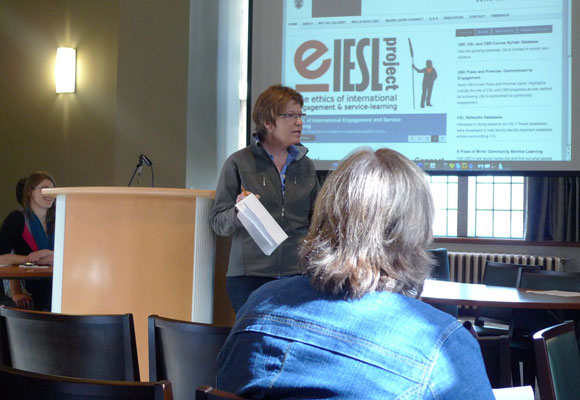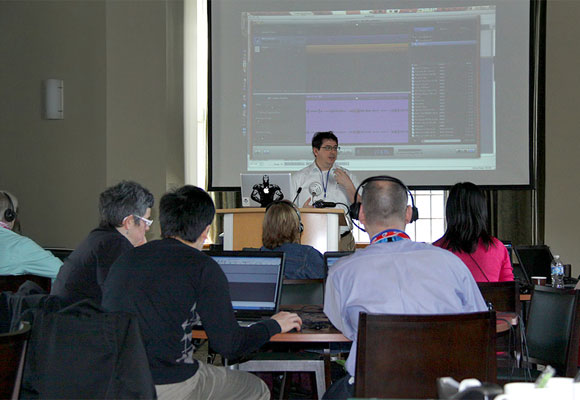EDUCamp 2010, which took place on March 18, offered attendees a day of thinking and learning about sustainability education and the value of learning technologies. Concurrent morning “thinking” sessions were complimented by the afternoon “doing” sessions.
Thinking Session I: Partnerships in Learning and Service
Thinking Session I: Partnerships in Learning and Service introduced the pedagogical components of Community Service Learning and its links to sustainability. Community Service Learning (CSL) refers to a model of experiential learning that combines classroom learning with volunteer work to achieve community goals. This session highlighted how real-life experiences in the community are linked to academic content through processes of critical reflection such as journal writing, small group discussion, and writing analytical papers.
 Together facilitators Susan Nesbit (Senior Instructor, Civil Engineering), Susan Grossman (Associate Director, UBC Community Learning Initiative), and Danielle Blond (Coordinator, Communities of Practice, UBC Learning Exchange) led participants through an overview of Community Service Learning at UBC. After Susan Grossman provided a concise and informative introduction to CSL, Susan Nesbit discussed her work in the Faculty of Applied Science, just one of the University’s Faculties that engages in CSL. For three years the Faculty of Applied Science has incorporated CSL into Civil Engineering 201/202 as a core course component to provide experiential learning for its 2nd year students. For a list of all Faculties and Schools involved in CSL, go here.
Together facilitators Susan Nesbit (Senior Instructor, Civil Engineering), Susan Grossman (Associate Director, UBC Community Learning Initiative), and Danielle Blond (Coordinator, Communities of Practice, UBC Learning Exchange) led participants through an overview of Community Service Learning at UBC. After Susan Grossman provided a concise and informative introduction to CSL, Susan Nesbit discussed her work in the Faculty of Applied Science, just one of the University’s Faculties that engages in CSL. For three years the Faculty of Applied Science has incorporated CSL into Civil Engineering 201/202 as a core course component to provide experiential learning for its 2nd year students. For a list of all Faculties and Schools involved in CSL, go here.
Civil Engineering students, Val, Dennis and Andrew shared their experiences and comments about participating in CSL projects. In this discussion they revealed some of the valuable and variable skills they obtained through their learning experience. The course provided them with insight into their future profession, taught them concepts about civil engineering in the real world, developed their project management and design skills, and showed them the importance of sustainability. Their stories reflected the diversity of projects undertaken by students in the course. With her group, Val designed, proposed, built and tested a model exhibit to educate Science World visitors about water-use and conservation practices, based on the concept of fluid mechanics. She shared “This project allowed us to engage in collaborative interaction with our partners (Science World).” In contrast, Dennis’ team developed a grey water filter to redirect water to the rooftop garden of the YWCA at Crabtree Corner. His learning did not stop there; his team even developed a website to support and promote this initiative. Dennis explained “There was a fair amount of self-directed learning that will better prepare me for 3rd and 4th year. Also, I learned a lot about the Downtown Eastside, the community my project would serve.”
 The session wrapped up with Danielle Blond’s final words, spoken from France via Skype, about a newly launched website to advance CSL. Developed as a tool to support those involved in CSL, this dynamic and interactive website showcases CSL projects, allows for the sharing of resources, highlights upcoming events, and encourages connections through the Q&A tab. Interested in learning through action? Visit the Community Service Learning website!
The session wrapped up with Danielle Blond’s final words, spoken from France via Skype, about a newly launched website to advance CSL. Developed as a tool to support those involved in CSL, this dynamic and interactive website showcases CSL projects, allows for the sharing of resources, highlights upcoming events, and encourages connections through the Q&A tab. Interested in learning through action? Visit the Community Service Learning website!
Doing Session II – Introduction to Audio and Video Podcasting
Podcasting is a powerful tool that instructors can use to deliver additional resources to students. It can be used from everything from recapping lectures to broadcasting details on a new research report.
 Tris Hussey is a writer, teacher, blogger, and speaker on all facets of Internet life, WordPress, and social media. He gave an overview of the fundamentals of podcasting in one of the afternoon sessions at EDUCamp 2010. Tris, an avid blogger, has a passion for teaching this topic and has done so for many years. He hoped to give attendees the confidence to use podcasting and to demystify the multitude of tools and strategies available for creating the perfect podcast.
Tris Hussey is a writer, teacher, blogger, and speaker on all facets of Internet life, WordPress, and social media. He gave an overview of the fundamentals of podcasting in one of the afternoon sessions at EDUCamp 2010. Tris, an avid blogger, has a passion for teaching this topic and has done so for many years. He hoped to give attendees the confidence to use podcasting and to demystify the multitude of tools and strategies available for creating the perfect podcast.
Audacity was the program of choice for PC users (not available on Macs), which Tris recommended. It is a free program that, while not too aesthetically pleasing, is a powerful full-featured tool. Due to legal issues, Audacity does not include a MP3 encoder. Tris emphasized that one must download Lame MP3 Encoder beforehand in order to export files as an MP3. Aside from this slight hurdle, Audacity is pretty straight forward to use, although Tris recommended that new users experiment with the program before attempting their first real podcast.
For the Mac users, Tris highly recommended GarageBand (not available on PCs), since it is already pre-installed into most Macs. The advantage of this program is that (unlike Audacity) an MP3 encoder is included with the software, making GarageBand a formidable all-around tool. A unique feature of GarageBand is its pre-programmed sound loops which make it easy for users to create fairly professional introductions and transitional music.
Tris gave five general rules of thumb for creating high quality podcasts.
- Make sure the audio file is encoded at a bit rate of more than 96kps. The lower the bit rate, the smaller the file size, and the lower the quality of sound.
- Use the mono setting instead of stereo, because stereo is not a necessity for podcasts which involve straight forward lecturing.
- If you are creating video podcasts, record the audio and video components separately. The main advantage of this rule is that a dedicated audio channel will allow for a higher quality of sound, and is generally more pleasing to the ear.
- When recording, use a pop filter, which will eliminate the hard sounds that come from the consonant “p”. Professional pop filters can be expensive, so Tris suggested that a homemade one can be made with a wire hanger and panty hose.
- End the podcast with a smooth transition. This means to fade out the audio which makes the broadcast easier to listen to. This trick is widely used in radio as well.
The audience not only got great fundamental knowledge on the production of podcasts, but they also were given the opportunity to try out these new techniques on training laptops. Although some were overwhelmed by the information, the majority in the audience felt that this session was informative and much needed. With Tris’ guidance, the audience was able to start producing podcasts for their own educational projects or personal use.

